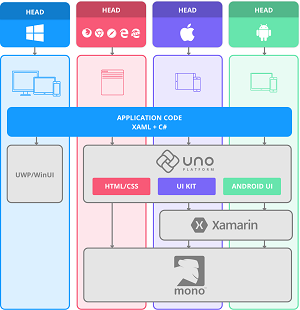News
Open Source Uno Platform Takes Xamarin.Forms Mobile Apps to the Web via WebAssembly
The open source Uno Platform announced new integration with Xamarin.Forms that lets developers take existing XF mobile apps to the Web, using WebAssembly.
With an original focus on creating Universal Windows Platform (UWP) mobile apps, the Uno Platform is described as a UWP bridge that allows UWP-based code to run on iOS, Android and WebAssembly. It claims to be the only platform that can be used to build native mobile, desktop and WebAssembly apps with C# and XAML from a single codebase.
WebAssembly, which backs Microsoft's Blazor project, provides a low-level assembly-like language compilation target for high-level languages (like C/C++, C#, Rust) so they can be used for Web development instead of relying on JavaScript, long the dominant language for browser-based development.
The commercial steward of the open source Uno Project, nventive Inc., today (Sept. 19) announced new integration with Xamarin.Forms that provides WebAssembly renderers that enable developers to extend existing Xamarin.Forms-based apps to the Web simply by executing a single line in the Visual Studio Command Prompt.
 [Click on image for larger view.] Uno Platform (source: Uno Platform).
[Click on image for larger view.] Uno Platform (source: Uno Platform).
That functionality comes with today's announcement of Uno Platform 2.0. "While UWP was, and still is, our first love, with today's announcements we are keeping pace with our audience asks and we are shifting gears towards ensuring the future WinUI stack can be run everywhere -- WebAssembly, iOS, Android, and of course Windows," reads a Uno Platform blog post.
"One of the largest challenges mobile developers face is the inability to take business logic developed for their mobile-first applications to the Web," the Uno Platform team said in a news release. "Xamarin Forms had enabled thousands of C# developers to quickly develop single-codebase enterprise apps for iOS and Android, a common request at enterprises as single-codebase cross-platform apps have proven to bring savings in development and maintenance cost. Now, with the new integration of Xamarin Forms and Uno Platform, those apps can be expanded to modern browsers by executing a single line in Visual Studio Command Prompt."
In addition to the WebAssembly renderers for Xamarin.Forms, Uno Platform 2.0 includes:
- XAML Hot Reload for Uno Platform preview
- Support for SkiaSharp.Extended for WebAssembly
- UI testing
- Dozens of performance, stability and usability features
- Uno Platform user group support program
About the Author
David Ramel is an editor and writer for Converge360.